Advice from some of the best alcohol ink artists on Instagram
- Anuja Aggarwal
- Jul 19, 2021
- 10 min read
Are you curious about starting your journey in alcohol ink art? Have you already worked with alcohol inks for a while and want to know what else can you do to move forward in your journey? This article is a compilation of hard-to-find advice from 13 artists who have created their own styles of art with alcohol inks and are among the most renowned on Instagram. If anyone works with alcohol inks, they know these artists. They have given advice for beginners in the field as well as for people who have been working with inks for a while now. The article has great information for newcomers who want to start working with alcohol inks, or are struggling to work with inks, as well as professionals who want to take it a step forward.
(The world is full of wonderful artists. There are many other amazing alcohol ink artists and we did not cover all of them in this article. If you are an artist and would like to give some advice to others based on your experience, please feel free to leave that in the comments. A big thanks to all the artists who generously offered their whole-hearted advice.)
Please note: The artists are listed in the order the answers were received.
Lone Zimino – “Share your experiences with others, no one can make the same painting as you anyway.”

Lone Zimino
(Denmark)
Instagram: https://www.instagram.com/ziminoart/
For beginners:
Always start with a few drops of ink, you can always build on your painting with more ink, use twice as much alcohol as you use ink.
Do not get frustrated, it is harder than it seems to be.
Always work with ink safely, outdoors or with a mask.
For people who have been there for a while:
Push yourself to new techniques, you learn something new every time you step out of your comfort zone.
Share your experiences with others, no one can make the same painting as you anyway.
Experience the world of mixed media with alcohol ink, you can mix with everything else where there is no alcohol in.
Kimberly Deene Langlois – “Allow yourself to play, experiment, and enjoy the process of creating.”

Kimberly Deene Langlois
(USA)
Web link: https://linktr.ee/Kimberlydeene
For beginners:
Be patient with yourself and with the inks. Let the inks flow and shape organically at first so you can appreciate the unique idiosyncrasies of this medium. Allow yourself to play, experiment, and enjoy the process of creating.
For people who have been there for a while:
Practice, practice, practice when trying a new technique. Continue to reactivate the inks with alcohol to transform your paintings. Don’t be afraid to make changes if you’re not completely satisfied. You may not always get the result you’re going for, but alcohol ink can sometimes surprise you with magical results.
Polina – “If you think that you cannot do something, this only means that you cannot do it yet.”

Polina
(Russia)
Instagram: https://www.instagram.com/mone_i_mane/
Web link: https://www.moneimane.ru/
There are so many things that I know now about alcohol ink art and about this world and I wish I knew when I started my way in art. So, I'd like to share a couple of my personal insights with you and I hope you'll find them useful.
For beginners:
Practice, practice, practice: don't underestimate the importance of constant daily practice. If you think that you cannot do something, this only means that you cannot do it yet. Keep working, try to find 10-30 minutes for practice every day, be patient and the result won't take long to come.
Listen to yourself: Even if you're only at the beginning of your alcohol ink journey it's quite important to listen to yourself and try to find your strengths. When you feel that some effects turn out better than others make it look like your distinctive feature. Your unique style is being formed from such features.
For people who have been there for a while:
Never stop learning: Even if you're a successful artist who sells their artworks worldwide and well-known in the alcohol ink world, just never stop looking for something new: new ideas, new inspirations, new styles, new techniques, new education, etc.
Don't accept someone else's work as a reference for a commission: I always ask customers to send me some examples of my own works (from my IG account) which they like or want me to create. Even if you're a great artist in alcohol ink technique it's impossible to copy someone else's work. It's going to have your style, attitude and in general have different vibes. So, the customer might get disappointed with the result.
Johanna Koskinen – “Take time to create your own, unique style. Your work doesn't have to, or should look like someone else's: it's your art, your voice and creation.”

Johanna Koskinen
(Finland)
Web link: https://www.johannakoskinen.art/
For beginners:
Try to keep practicing and painting fun! At first, It's all about experimenting and just creating something, and eventually what you paint will be successful! Don't be afraid to make technical mistakes, I have learned so much more from my mistakes, than from those easy painting sessions.
Try to get enough information about materials and basic techniques, so you won't waist time for mistakes, that could be avoided, and which only drag your motivation down.
For people who have been there for a while:
Take time to create your own, unique style. Your work doesn't have to, or should look like someone else's: it's your art, your voice and creation. Don't compare yourself too much to others, and trust yourself as an artist.
Practice, practice, practice. Keep painting fun, but regular!
Anuja Aggarwal - "Turn those 'happy accidents' into 'intentional artworks'."

Anuja Aggarwal
(India)
Instagram: https://www.instagram.com/anujaaggarwal/
Web link: https://www.pieceofmyart.in/
For beginners:
Many beginners try out this medium because they see the online sped-up videos and feel that it’s easy, but later realize that it’s not as easy as it looks. At this point many of them give up, but please understand that the videos that you see are from artists who have practiced for many days or months and are often displaying their best works on social media. Know that it is going to take some time and practice, and is not just a one-time art or craft activity.
The best way to learn is to experiment. Try different brands or inks, different colors or surfaces, vary the tools that you use, play around with techniques. Don’t plan to create a masterpiece each time. First, just try to get an understanding of how the inks behave in different conditions and figure out what you enjoy doing with them the most.
There’s no shortcut to practicing. Do it as often as possible and soon you will be getting better control of what you want to achieve with inks.
Take safety precautions seriously.
For people who have been there for a while:
Once you are comfortable with the basics of working with inks it’s time to think in terms of composition that turn those “happy accidents” into “intentional artworks”.
There are no rules, there’s nothing wrong or right – do what you like with inks, experiment with other mediums along with inks.
Don’t let other artist’s journey influence you. Take your time and keep working on techniques that you like.
Jaide Fox – “It is essential to learn how to create an intentional composition while maintaining the fun energy of the inks.”

Jaide Fox
(Canada)
Instagram: https://www.instagram.com/jaidefoxpaintings/
Web link: https://jaidefoxpaintings.com/
For beginners:
I recommend exploration. Make a color swatch sheet and learn your colors and how they interact with each other. Try different tools, brushes, and methods to dry the ink to create different compositions. Creating abstract artwork with intention starts with knowing your medium inside and out, and how to manipulate it.
For people who have been there for a while:
For more advanced artists, the best thing you can do is learn about design theory and composition so you can create with intention (for example, the "rule of threes," hierarchy of elements, color harmony, alignment, and the power of contrast). The spontaneity and vibrancy of alcohol inks can overwhelm an artwork and it is essential to learn how to create an intentional composition while maintaining the fun energy of the inks.
Jan Matthews – “Don’t think that Alcohol ink paintings should just consist of wispy designs, it's far more versatile.”

Jan Matthews
(UK)
Instagram: https://www.instagram.com/janmatthewsart/
Web link: https://janmatthewsart.co.uk/
For beginners:
Use a white ceramic tile to practice on. Synthetic paper is expensive.
Nara paper doesn’t stain as much as Yupo, and can be virtually wiped clean.
Do not use 85 GSM synthetic paper. No matter how careful you are, it will warp with heat and be impossible to frame nicely.
For people who have been there for a while:
Try experimenting with brushes, droppers, mini spray bottles.
Don’t think that Alcohol ink paintings should just consist of wispy designs, it's far more versatile than that.
Use alcohol Ink markers to enhance and add to your work.
Kinga Johnson – “Enjoy the process, don't expect perfection, each piece is a beautifully unexpected adventure.”

Kinga Johnson
(US)
Instagram: https://www.instagram.com/art.aurelian/
Web link: https://www.etsy.com/shop/aurelianart
I feel like painting with alcohol inks helped me figure out and discover my inner child, it lets me try new things, like colors, paints, different techniques. I love how alcohol ink is unpredictable because it made me realize you can't control it all, and just go with the flow. So, if I had to give advice it would be in the words of Elsa: "Let it Go!". I sometimes even sing this song in my head as I paint, so I try not to worry about a few drops ending up on the wrong place or colors not mixing how I wanted to. So just keep exploring, comparing, having fun and play. I feel like it keeps me young, looking forward to the next day, to the next small painting adventure. So Let it Go, or find your own favorite song and just have fun! Enjoy the process, don't expect perfection, each piece is a beautifully unexpected adventure.
Michelle Whitehead – “When you’re excited about what you’re creating, it shows through in your work!”

Michelle Whitehead
(US)
Instagram: https://www.instagram.com/michelle.lynn.art/
Web link: https://www.michellelynnart.com/
For beginners:
If you’re just starting out with alcohol inks, my best advice is to just keep practicing and experimenting until you really understand the inks’ properties. Especially with this medium, it’s really important to understand this. Once you understand how the inks move and behave, then you will then be able to manipulate them the way you want. Another important piece of advice for beginners is to always be safe! Make sure you invest in a good respirator mask, gloves, and air purifier, and work in a well-ventilated space or outdoors if possible.
For people who have been there for a while:
If you’ve been painting with alcohol inks for a while, don’t forget to allow yourself time to explore. Whether it’s a new style, substrate, or a totally different medium, I think it’s important to let your creativity wander and grow. When you’re excited about what you’re creating, it shows through in your work!
Sequoia Hornsby – “Enjoy the never-ending learning process!”

Sequoia Hornsby
(Ireland)
Instagram: https://www.instagram.com/coyasauce/
Web link: www.coyasauce.com
For beginners:
I think the most important thing is to be patient and not expect to make amazing art right away. Give yourself time to experiment and try different techniques, without trying to make anything perfect!
Ask questions, like what would happen if you changed the angle of the hairdryer, or painted outside, etc. This will show you how the inks react in different situations, and you'll figure out how to get the effects you want.
And practice consistently, every day if you can (that's what helped me the most). Shorter, frequent painting sessions are more helpful then the occasional long one. So have fun, be patient and kind to yourself, and enjoy the colourful journey!
For people who have been there for a while:
When you're comfortable with the basics, continue challenging yourself, for example see if you can recreate your favourite effects but on a much larger (or smaller) scale. See if there are any different or new effects that you like, perhaps add other mediums like acrylic inks to the mix.
We all want to find our own artistic voice, so don't get hung up on what other people are creating. Try to find the limits of what you know and expand them.
When you start to understand how and why the inks move the way they do, you can really develop your techniques and make something unique. So, enjoy the never-ending learning process!
Anne Roos – “Keep calm and be patient, good things take time.”

Anne Roos
(Netherlands)
Instagram: https://www.instagram.com/anneroosart/
For beginners:
My advice when you’re starting to master the art of alcohol inks is to keep calm and experiment! I know how frustrating the process sometimes (or a lot of the times) can be in the beginning. You see all those beautiful pieces on social media and videos in which it all looks so easy, until you try and do it yourself. In the beginning, try and enjoy the process and don’t aim to create perfectly hangable pieces right away. There’s a learning curve, which keeps continuing. Even after having done alcohol inks for about 2.5 years, I am still not able to master all of the techniques that are out there. That’s what makes alcohol inks such an exciting medium to work with! Try and focus on one or two specific techniques or styles, and don’t try and master everything at once (I can tell you, I’ve been there).
The key to mastering alcohol inks is to experiment and practice a LOT. As they say, it takes at least 1000 hours to master something, and that is definitely true for alcohol inks as well. Invest in a good workshop or course or use YouTube videos get a better understanding of how to work with alcohol inks and learn about different techniques. But after that, practice lots and experiment to develop your own way of working with the inks. Dare to fail and learn from them (about what you should and shouldn’t do)! Take out the parts that you do like and analyze how you achieved those results and continue from there.
For people who have been there for a while:
When you’re starting to get the hang of it and want to take your alcohol ink art to the next level, try and develop your own style. That takes time! Try and focus not too much on what everyone else is doing, but on you and what you like to create. If you want to sell your art, start small and simple, and promote your pieces on social media or start an Etsy shop. But unlike what social media sometimes suggests: Selling art online is hard and doesn’t come over night! I don’t mean that as discouragement but as encouragement to keep going and don’t expect to be successful right away. Don’t forget that the successful artists you see on social media usually have already invested a lot of time in their art businesses.
I think the bottom line of all of this advice is to keep calm and be patient, good things take time. Don’t forget to enjoy the process in the meantime!
Ksenya – “Learn the basics of abstract composition and color theory.”

Ksenya
(Moscow)
Instagram: https://www.instagram.com/_ksenyart_/
For Beginners:
To create an air pattern, it is better to choose refills for alcohol-based markers. For a more saturated and dense drawing, use alcohol-based ink.
The main tools for working in this technique are a hair dryer and an airbrush. I recommend using low-power tools to be able to create soft color gradients
Select non-porous surfaces such as synthetic paper, laminated wood, plastic, metal, mirror, plexiglass.
Learn the basics of abstract composition and color theory. This is an important component of the formation of your own style in creativity.
For people who have been there for a while:
Just practice and explore additional opportunities to improve your skills.
Marissa Recker - “Experimentation feeds creativity.”

Marissa Recker
(USA)
Instagram: https://www.instagram.com/astuaryart/
Web link: https://www.astuaryart.com/
For Beginners:
Enjoy the journey! Fluid art is a difficult medium, but it is one that rewards persistence. Don't be afraid to try other surfaces, techniques, and materials to find what effects you connect with.
For people who have been there for a while:
Keep pushing yourself to create something new. Continue to challenge yourself to create something different from anything you've ever made. Experimentation feeds creativity. If you would like to get more movement and fade in you work, try using more isopropyl alcohol!